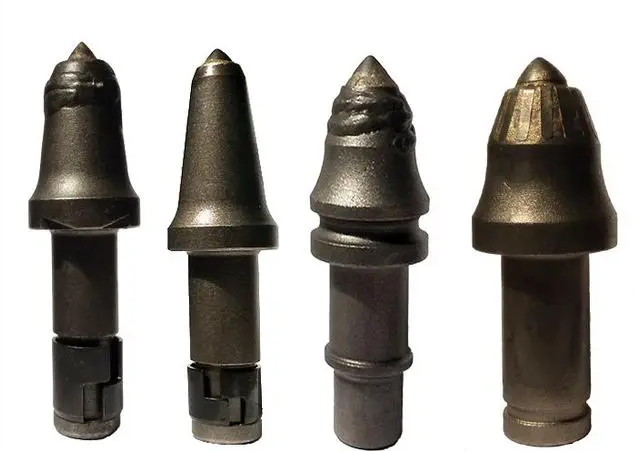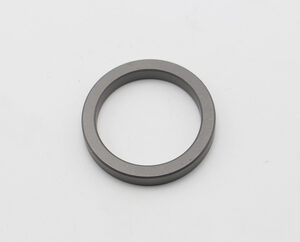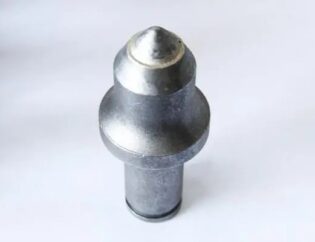During coal cutting, mining bits rotate and cut under high cyclic compressive stress, shear and bending stress, periodic or sudden impact loads, and intense frictional heat generated by the contact with coal rock. The cutting edge can reach a temperature of 600-800℃, resulting in significant thermal stresses, as well as other mechanical behaviors such as contact fatigue and even fracture. Under such complex working conditions, mining bits are prone to failure. To effectively extend the service life of these bits and reduce coal mining costs, it is crucial to identify their main failure modes and causes by conducting failure analysis.

1Failure modes
Carbide coal mining bits are subjected to high cyclic compressive stress, shear and bending stress, periodic or sudden impact loads, thermal stresses, wear, and other effects during coal cutting. Although coal is not particularly hard, they often encounter harder minerals such as quartz and gangue during operation, resulting in failures such as carbide fracture, wear, and breakage.
2 Failure analysis
2.1 Fracture of coal mining bits
During coal cutting, the carbide tooth is exposed to high compressive stress and impact load, leading to poor contact with the coal seam. The stresses can cause impact fatigue, resulting in cracks and the falling off of large pieces. Fracture occurs when the stress exceeds the bending strength limit of the carbide. In addition, during the cutting process, the temperature of the tooth head rapidly increases due to friction, while it rapidly decreases during idle rotation. This process subjects the carbide tooth to periodic tensile-compressive thermal stress, and with the cyclic action of this stress, thermal fatigue cracks will be produced, leading to the fracture of the mining bits. The insufficient bending strength of the carbide is the main cause of fracture, and micro-defects can also produce stress concentration areas leading to fracture.
2.2 Wear of coal mining bits
During the process of coal cutting, the coal mining bits?come into direct contact with coal and rock, which results in mutual abrasion. Due to the existence of impurities such as quartz and coal gangue with strong wear resistance in the coal seam, impact fatigue and abrasive cutting will occur, which will cause abrasive wear failure to the cutting teeth. When the coal mining machine coal mining bits?cut through the coal seam, friction generates heat, resulting in a high temperature of 600-800℃ on the surface of the coal mining bits. The temperature rises and falls alternately, which makes the mining cutting teeth suffer from thermal fatigue wear. Meanwhile, under the alternating impact load, the surface of the coal mining bits?will deform and gradually form microscopic cracks. The cracks will continuously expand under periodic impact loads, and the surface cobalt phase will be preferentially consumed. The WC particles will detach due to the loss of the cobalt phase’s bonding effect, eventually resulting in large-scale peeling of the carbide?particles. In addition, there will also be phenomena of large WC particles breaking and losing during the coal cutting process.
2.3 Fracture of coal mining bits
Hard coal mining bits?contain certain inherent defects such as pores, cobalt pools, surface microcracks, and coarse WC particles, which can cause stress concentration and become the fracture source of the carbide. During the coal mining process, due to repeated impacts, extrusions, and wear, the cobalt phase is preferentially squeezed out and lost. The bonding between the WC particles that are bonded together by the cobalt phase’s bonding effect is destroyed, and the WC particles detach. At the same time, at the site where the WC particles are broken and detached due to the impact load, stress concentration will also occur, which is prone to induce the formation and extension of cracks.
3Measures to Improve the Performance of coal mining bits
Based on the analysis of the article, the main reasons for the failure of cemented coal mining bits?are:
- The bending strength of the carbideis not enough, and the instantaneous impact load during work can easily reach or even exceed the bending strength value of the carbide.
- Quartz and gangue in the coal seam cause wear on the carbide.
- Fatigue cracks caused by periodic and sudden impact loads and frictional heat generated by severe friction between the coal mining bitsand the coal seam.
Therefore, in order to improve the efficiency of using cemented coal mining bits, efforts should be made to improve the bending strength, wear resistance, and fatigue resistance of the carbide?in the preparation stage. At the same time, the cooling force of the teeth should be increased during use to reduce the hot and cold cycles of the coal mining bits?and prolong their service life.
3.1 Improve the strength and toughness of coal mining bits
Porosity, WC grain size and distribution, and density differences between the upper and lower parts of cemented carbide are the main factors affecting bending strength and toughness. Currently, people mainly use methods such as preparing non-uniform structure cemented carbide, using coarse-grained ore, gradient structure cemented carbide, adding trace elements to modify the bonding phase, and using new molding and sintering processes to improve the strength and toughness of cemented carbide, thereby prolonging the service life of the carbide. The engineers of Metallurgical Ultra Hard Materials Co., Ltd. believe that, under the premise of appropriately reducing the cobalt content of the carbide, cemented carbide with an average grain size of 5.8 μm WC should be produced. By comparing with ordinary cemented carbide, it is found that the bending strength and toughness of the cemented coal mining bits?produced using coarse-grained WC and low Co content have been improved. In other words, while the coarse-grained carbide?has high wear resistance, its strength and toughness have also been improved.
3.2 Improve the wear resistance of coal mining bits
The wear resistance of cemented carbide is determined by the microstructure and chemical composition of the carbide. Currently, in order to ensure that cemented carbide cutting teeth have good strength and toughness, the cobalt content of the cemented carbide carbide?is generally high. People mainly study the microstructure of cemented carbide, adjust the chemical composition of the carbide, and control the mechanical and physical properties of the carbide?(such as strength, hardness, toughness, etc.) to improve the wear resistance of the carbide. An article pointed out that the wear resistance of the carbide?can be effectively improved by minimizing the occurrence and growth of carbide?defects and adding an appropriate amount of rare earth elements.
3.3 Improve the fatigue resistance of coal mining bits
Cobalt content and WC grain size are the main factors affecting the fatigue resistance of cemented carbide. The production and expansion depth and speed of thermal fatigue cracks gradually decrease with the increase of cobalt content or WC grain size in the carbide. In addition, the increase in WC grain size will also increase the average free path of the cobalt phase, thereby improving the fatigue resistance of the carbide.
結(jié)論
Metyou Carbide Co., Ltd. has conducted a failure analysis on the used carbide coal-cutting teeth recovered from customers and reached the following conclusions:
1)the main forms of carbide coal-cutting teeth failure are fracture, wear, and breakage.
2) the main causes of coal mining bits?failure are insufficient bending strength, poor wear resistance, and poor fatigue resistance of the carbide.
3) the service life of carbide coal-cutting teeth can be improved by means of improving the purity of raw materials, changing the carbide?composition, optimizing the forming and sintering process, controlling the grain size of the carbide, and conducting heat treatment on the carbide.







